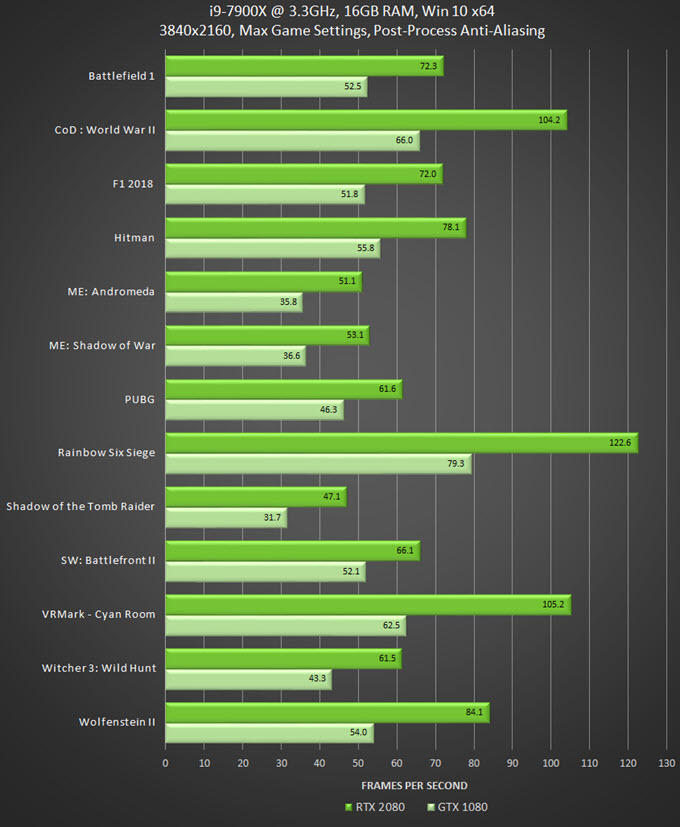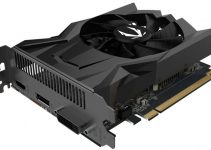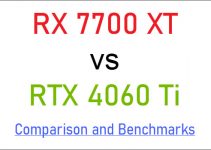Both GeForce RTX 2080 and GTX 1080 are high-end graphics cards and the second most powerful graphics cards in their respective series. GeForce GTX 1080, as we all know is the Nvidia’s flagship graphics card for a long time and it still packs a punch even after the release of new high-end graphics cards in the RTX 20 series. GeForce RTX 2080 is a new graphics card and its position comes after the mighty RTX 2080 Ti which is currently the most powerful gaming graphics card ever built.

These new top-of-the-line RTX 20 series graphics cards come with some new features that are not present in the GTX 10 series cards. Also, most of the users are still confused, about whether they should go for the newer RTX 2080 or they should be better off with GTX 1080 which is still capable of running most of the latest games at 4K on ultra graphics settings. So, to make things clear and concise, here I am going to make a complete comparison between RTX 2080 and GTX 1080 so that you can clearly decide which card will suit you the best.
Read also:
- RTX 2080 vs GTX 1080 Ti Comparison
- RTX 2080 Ti vs GTX 1080 Ti Comparison
- RTX 2070 vs GTX 1070 vs GTX 1080 Comparison
RTX 2080 vs GTX 1080 Comparison
Here is a very precise comparison between GTX 1080 and RTX 2080 cards based on their specifications, features, performance, power consumption and pricing. The comparison is done between Founders Edition of both these graphics cards, which is taken as a reference card.
GPU Architecture
GeForce RTX 2080 is built on the Turing GPU architecture which is the latest and one of the most advanced GPU architectures ever built. The card comes with 2944 CUDA Cores and for Real Time Ray Tracing and AI / Deep Learning, it comes with RT Cores and Tensor Cores respectively. RTX 2080 is built on the 12nm fabrication process and it is designed for 4K gaming, and can also serve as a good workstation card too. This new Turing architecture is much more advanced and powerful than the older Pascal GPU architecture when it comes to supporting advanced technologies and processing.
GeForce GTX 1080 uses Pascal GPU architecture which is seen on all the GTX 10 series graphics cards. It is still a good GPU architecture for gaming but it only got CUDA Cores, and is not capable of performing Real Time Ray Tracing, and also lacks in the AI and Deep learning departments too. However, the architecture is still powerful for running latest games on the highest settings and resolutions. The GTX 1080 card comes with 2560 CUDA Cores and is built on the 16nm fabrication process. However, some of the new GTX 10 series cards do use 14nm manufacturing process, particularly in the lower end of the series. You can check out the comparison between Pascal, Turing, and Volta GPU architectures from the link given below.
Must Read: Turing vs Volta vs Pascal Comparison
Video Memory (VRAM)
Both these graphics cards come with 8GB VRAM having 256-bit interface but they differ in memory type. GTX 1080 comes with GDDR5X memory which is faster than the GDDR5 memory. On the other hand, RTX 2080 comes with a much faster GDDR6 memory having speed of 14 Gbps which is considerably faster than the 10 Gbps speed of GDDR5X present in GTX 1080. This also results in a higher bandwidth of 448 GB/s in RTX 2080 compared to 320 GB/s offered by GTX 1080. Faster memory does help in gaming at higher resolutions, especially at 4K where more textures are loaded in the video memory and processed by the GPU.
Must Read: GDDR5 vs GDDR5X vs GDDR6 vs HBM2 Memory Comparison
Features
When it comes to features then RTX 2080 is clearly ahead of GTX 1080. However, both these cards support DirectX 12, Open 4.5, Vulkan API, G-Sync, SLI, Nvidia Ansel, and Nvidia GPU Boost. Features that are exclusive to RTX 2080 include Real Time Ray Tracing for enabling realistic shadows and lighting in games, and Deep Learning Super-Sampling (DLSS) which is a form of Anti-aliasing done using AI (Tensor Cores) and is much faster than the traditional Anti-aliasing techniques using Rasterization methods. RTX 2080 also includes a USB Type-C connector at the rear side that supports VirtualLink for connecting virtual reality (VR) headsets.
Gaming Performance
Now we come to the most important part which is the real-world gaming performance of these cards. Below you can check out the FPS benchmarks of these two cards in different games at 4K resolution.

Well, as you can clearly see that RTX 2080 is definitely faster than the good old GTX 1080 in all games. RTX 2080 is around 33% to 40% faster than the GTX 1080 and can run almost all the games on Max graphics settings at 4K with 60 FPS on average.
Power Consumption
In the power consumption department, GTX 1080 is clearly ahead with its power consumption figure of 180W while RTX 2080 consumes 225W of power. The difference of 45W in power consumption makes GTX 1080 much more power-efficient and it requires 500W PSU only for its working, while on the other hand, the recommended PSU for RTX 2080 is 650W.
Check out: Best PSU for High-end Graphics Cards
Pricing & Availability
Founders Edition of RTX 2080 retails at $799 MSRP while that of GTX 1080 at $549. This equates to a difference of 250 dollars in the pricing of these cards and it makes GTX 1080 a better value for money card. Also, GTX 1080 is readily available while RTX 2080 is currently hard to find because it is a newer card and most of them are already out of stock on various online sites. You can check the current pricing of both these cards from different graphics card manufacturers from the links given below:
Check GeForce GTX 1080 Price on Amazon
Check GeForce RTX 2080 Price on Amazon
RTX 2080 and GTX 1080 Specifications
| Specifications | GTX 1080 | RTX 2080 |
| CUDA Cores | 2560 | 2944 |
| RT Cores | NA | 46 |
| Tensor Cores | NA | 368 |
| GPU Architecture | Pascal | Turing |
| Memory Size | 8GB GDDR5X | 8GB GDDR6 |
| Memory Speed | 10 Gbps | 14 Gbps |
| Memory Interface | 256-bit | 256-bit |
| Memory Bandwidth | 320 GB/s | 448 GB/s |
| Bus Interface | PCI Express 3.0 | PCI Express 3.0 |
| DirectX | 12 | 12 |
| OpenGL | 4.5 | 4.5 |
| Vulkan API | Yes | Yes |
| SLI support | Yes (SLI HB Bridge) | Yes (NVIDIA RTX NVLink Bridge) |
| VR Ready | Yes | Yes |
| G-Sync | Yes | Yes |
| Power Consumption | 180W | 225W |
| Recommended PSU | 500W | 650W |
Final Words & Conclusion
Well, clearly RTX 2080 is a much faster card but it also costs more. If you are willing to pay extra bucks and want a newer technology card, especially for 4K gaming then getting an RTX 2080 is a good idea. However, if you still want a powerful card that can dominate in 1440p gaming and is also capable of 4K gaming at a much lesser price and power consumption then GTX 1080 is still a great card to buy.
Also, GTX 1080 is readily available and its price has come down to a great extent, and you can now easily find a good aftermarket GTX 1080 card for well under 500 dollars. On the other hand, RTX 2080 availability is an issue for now and it is selling at 800 dollars or even more. So, if you don’t care about Ray tracing and DLSS, and want a powerful card for high-end gaming then getting a GTX 1080 would make much more sense especially if you are on a tight budget. For suggestions and your views on this topic, please leave a comment below.
(*This post may contain affiliate links, which means I may receive a small commission if you choose to purchase through the links I provide (at no extra cost to you). Thank you for supporting the work I put into this site!)

![Best RTX 5070 Models [Budget, SFF and Premium Models] Best RTX 5070 Models [Budget, SFF and Premium Models]](https://graphicscardhub.com/wp-content/uploads/2025/03/ASUS-PRIME-GeForce-RTX-5070-12GB-GDDR7-OC-Edition-211x150.jpg)

I purchased a ASUS ROG chimera laptop with a GTX 1080 and 256 GB ssd and 2 tb hdd, This machine has 2 power packs and beautiful display . The ROG G703GIXS71 17 in Intel i7 8th gen was $3000 and worth every penny, I’m running black ops 4 at 200 fps no problem and this beast can take anything you throw at it including VR. When I went to best buy the geek squad told me not to buy a 20 series card but stick with this laptop because the gtx 1080 ROG card is very close and there is no need for a R series card. No regrets I love it and Asus is a great company. Pros: powerful, super fast, durable, quality, preference, options, sound, ROG GAMING CENTER, 144 Hz , Intel core i7 _7820HK ,G SYNC, 17 in ips panel, and a lot more. CONS : 2 POWER SUPPLIES, HEAVY.
Hi,
What about the newer laptops that run a core i9? Any feedback on them. Note: I have a laptop for about 2 or 3 years, then I get a new one. Mostly, I know what I want – “mostly” is the keyword here!
Any and all help would be appreciated. Thanks!
Regards,
Ed L
Well, most of the Core i9 laptops do have heating issues where the CPU throttles down to lower frequency and you will not get the maximum performance out of it. So, I think it is better to stick with the Core i7-8750H only.
Hi, Thanks for feedback. Do you think the i9 will do something to get rid of the heating issues? It is not a problem waiting a few months and up to six months. Thanks for your help!
Well, there is nothing wrong with the Core i9 as such when it comes to heating. The thing is that the processor is quite fast and the cooling unit in laptops with thin design is not enough for it. So, if you are not going for an ultra-thin or slim laptop, then you can consider Core i9.
Hi, I want a core i9 because I thought it was faster. On the web several pages show how fast processors are, but they don’t show an i9 yet. Even though I can wait awhile – anywhere from
2-4 months – is it worth waiting? Maybe then there will be a graph that shows how fast an i9 is against other processors. I want to use a 17 inch laptop. One that is not over 5 lbs. A 6 pounder
is OK – if it is faster. But, there are only a few laptops that are 17 inches that use an i9. Like I said,
it is worth the wait – if the wait is not too long. My guess is about 3 maybe 4 months. Otherwise it will be better to buy a lesser system. More to think about. Thanks!